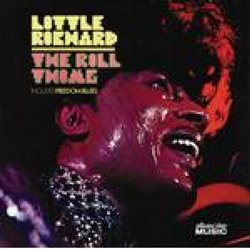+1/2 -- Striking, swampy 1970 comeback from a rock `n' roll
hyperbolium | Earth, USA | 06/28/2009
(4 out of 5 stars)
"Had Little Richard's rock `n' roll career ended with his 1957 turn to the ministry, he'd still be remembered as a powerful, flamboyant singer who reeled off a string of unforgettable, incendiary singles for Art Rupe's Specialty Records. His early `60s return to rock, fueled in part by attention from the British Invasion, resulted in some good sides in his signature style, but it wasn't until his 1970 signing with Reprise that he really found an updated sound that made the most of his gospel power and rock `n' roll fire.
Recorded in Muscle Shoals, the rhythm section on these sessions is propulsive and the electric guitars swampy. Richard's gospel-based belting turns out to be a perfect fit for the solid rhythms, heavy bass lines and superb sax solos. A couple of tracks, notably Esquerita's "Dew Drop Inn" (kicking off with the drum riff that opened "I Hear You Knockin'"), capture the abandon of Richard's 1950s sides, but others, such as the album's lead-off single, "Freedom Blues" and the Allman-styled blues "Two-Time Loser" are funkier and deeper in message.
Richard is in stellar voice throughout, adding a testifying edge to Travis Wammack's swampy "Greenwood, Mississippi" and belting out the original "Spreadin' Natta, What's the Matter?" A New Orleans' styled cover of "Lovesick Blues" is almost unrecognizable as the song Hank Williams took to the top of the charts, and the closing arrangement of the Beatles "I Saw Her Standing There" adds horns and a Southern sound. The album's 10-minute title track is a Crusaders-styled instrumental with Richard on electric piano backed by horns, guitar and a punchy rhythm section.
Though the album received a great deal of critical praise at the time, it stiffed commercially, failing to chart and lobbing its two singles shy of the top-40. The world may not have been ready for the second coming of Little Richard, but as this reissue attests, he continued to be a vital singer, songwriter, pianist and arranger whose power and vision weren't stuck in the past. Though he could have repeated his 1950s hits on the oldies circuit forever, he continued to more forward artistically, even if the market didn't take notice. 4-1/2 stars, if allowed fractional ratings. [©2009 hyperbolium dot com]"
Self-produced, excellent Comeback effort
Phil S. | USA | 06/25/2009
(5 out of 5 stars)
"Unlike many of Richard's '60s and '70s albums, this one really dug into his roots and yielded a vety satisfying album/CD. I don't care for the stereo separation, which places the drums on the right channel only, for the reedy bass, but this approach places the great man in the center sonic zone and his voice resonates at full capacity. The cuts were recorded in March and June of 1970, when he never sounded better.
There's a great jump-blues here, originally from Penniman friend, Esquerita, called "Dew Drop Inn", yes the site where R & R was born; where LR demonstrated to all what he really had in mind during that first New Orleans recording session - a wop bop a lu bop b'lop bam boom.............
Completely different, fully contemporary, employing an electric piano, is the surging and mysterious beat ballad, Somebody Saw You. (I think somebody *heard* it....Michael Jackson - Billie Jean, right?).
There is a long intsrumental to open the original "Side Two", a very engaging workout, featuring a creative keyboard from the Man himself. This long stretch, however, has remained a source of discontent for many who wanted more *songs* - like some of the numbers he'd knock out of the park on stage, at the time.
My, my, my."


 Track Listings (9) - Disc #1
Track Listings (9) - Disc #1